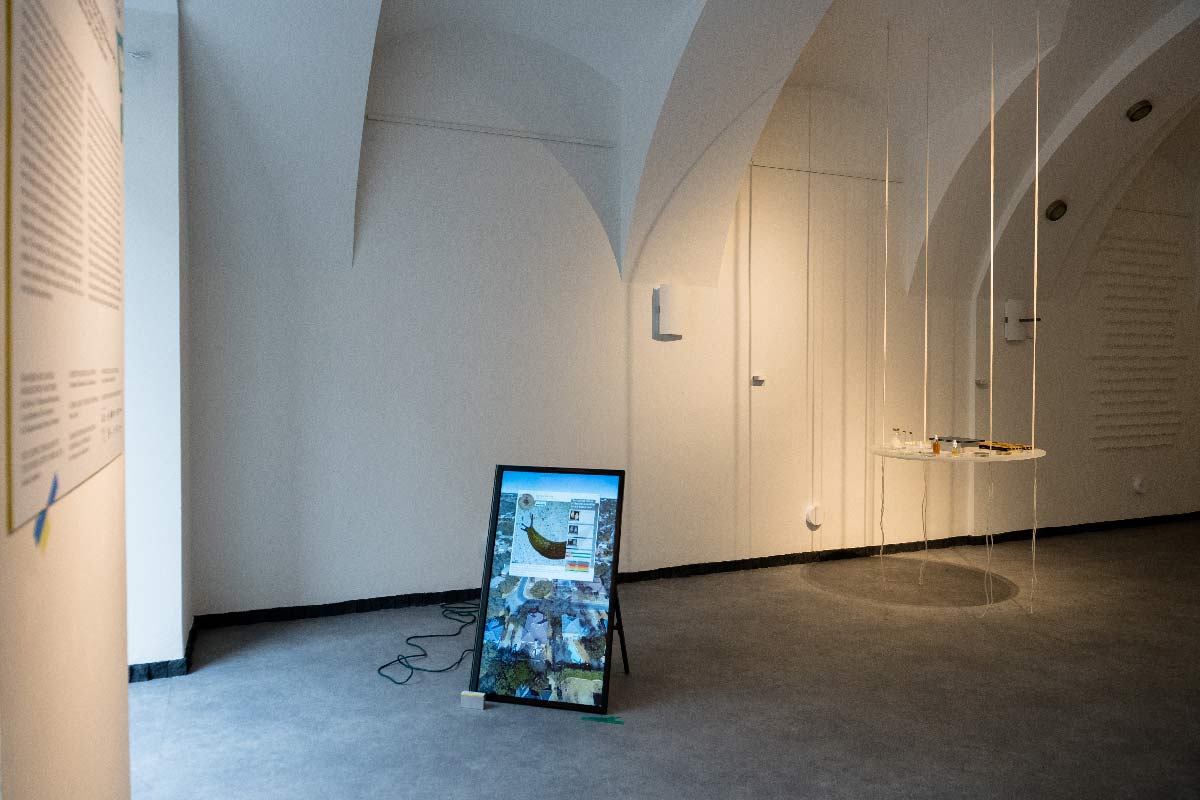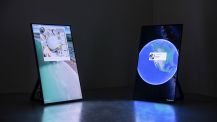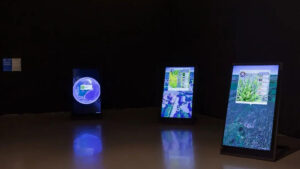Still Here
Staromestská Galéria Zichy, Bratislava, SlovakiaCurator: päť & pól
Artists: Ksenia Bilyk (Ukraine), Peter Brandt (Denmark), Amir Chasson (Britain, b. Israel), Marusya Chuprynenko (Ukraine), Maika Dieterich (Germany), Petra Garajová (Slovakia), Charmaine de Heij (the Netherlands), Jena Jang (South Korea), Marc Lee (Switzerland), Agata Milizia (Italy), Petra Nela Pučeková (Slovakia), Ojo Taiye (Nigeria)

Still Here Staromestská Galéria Zichy, Bratislava, Slovakia, photo: päť & pól
STILL HERE
CURATORIAL TEXT
Does it even make sense to keep counting the catastrophes that we are facing today? Is the current emergency rather one big crisis of our collective inability to imagine the future? Franco “Bifo” Berardi argues that: ‘The future becomes a threat when the collective imagination becomes incapable of seeing alternatives to trends leading to devastation, increased poverty, and violence.’1 The initial open call for the exhibition Still Here acknowledged the moment of crisis but understood it, more or less, as the Covid-19 pandemic, the environmental crisis and economic instability. However, during the duration of the open call another crisis emerged,which escalated to the war in Ukraine. Eula Biss writes in her book On Immunity that ‘our bodies may belong to us, but we ourselves belong to a larger body composed of many bodies.’2 Our bodies are interdependent through blood donation, vaccination or childbirth, but we are not only connected biologically, we are also connected socially, through networks. What we learned during the global pandemic was that we are all interconnected and depend on each other for our collective immunity, and this has become even more pertinent in the times of the war, which also highlighted our dependency on non-renewable resources. Asia Bazdyrieva writes that ‘Europe’s increased dependency on Russian oil and gas is driven by economic advantages and is folded into the mix of the continent’s generally advanced yet uncritical environmental concerns. Despite Europe’s rhetorical orientation towards resolving the environmental crisis, the material benefits of mining in countries with corrupt or authoritarian governments prevail, while the silence around these processes makes it impossible to address the climate issue at the level of real politics.’3 That is precisely how - in our current situation - one crisis not only overcomes the other, but even enhances it. As when blowing into the fire, each crisis adds more air over the coals and speeds up combustion into even bigger flames. Here we are, facing the spread of wildfires resulting from heat waves reminding us both of the climate emergency, and the above mentioned uncritical environmental political actions.
Still Here believes that contemporary art offers a useful tool to stimulate public dialogue in a performative and temporary way and that art has the potential to influence anti-authoritarian struggles, within which many art critics see the progressive and emancipatory legacy of the avant-garde.4 The exhibition acknowledges the importance of contemporary art production in imagining a new positive future, in empowering communities, in stimulating public dialogue and in healing our collective body. The artists in the exhibition - from their very varied positions, perspectives and different geographical locations - remind us that even though we all deal with different aspects of the current crises, we are all in it together. With their art, they are all trying to offer visions and proposals for a more positive future beyond the reality of our current global experience.
The violence and trauma linked to one’s gender and sexuality, especially in the context of the patriarchal and militant environment, is the theme of Peter Brand and Amir Chasson’s works. Brand’s work History of Violence explores the artist’s own experience of a near death, violent attack in Rome 2002. This work examines violence and trauma in relation to gender and sexuality. Chasson’s publication piece Loose Holes combines collages made from gay male magazines and poetry. The work comments on Russia’s invasion of Ukraine by looking at images of LGBTQ Ukrainians.
Reflecting on imperialism and colonialism, Ksenia Bilyk and Charmaine de Heij present their views on ways to overcome their traumatic histories. Bilyk’s work Urn for Ashes examines revolutionary Soviet totalitarianism in her ceramic urns with bullet point holes wishing for the collapse of the old imperialistic narratives. De Heij’s photographic project Sowtu Watra depicts the colonial relationship between the Netherlands, the sea and Suriname. The artist focuses on the sea as the place where the horrors, collective trauma and colonisation took place.
Language and communication are featured in the works by Maika Dietrich and Petra Nela Pučeková. Dietrich’s Grammar Animator is based on the aesthetics of language, in which a computer programme creates animations based on grammatical structures of different languages. When proposing a new future and stimulating dialogue, Dietrich’s work imagines the way we can communicate with each other beyond the traditional alphabet. Pučeková’s work How to Be Together? created during the pandemic reflects on the inevitable need for human contact. The work was based on five strangers spending four nights together in the woods in the woods while they were forbidden to communicate during the project duration. The work examines what kind of bond is formed without knowing anything about each other.
The climate emergency and our interconnectedness with other people and species is another common theme of the exhibited artworks by Petra Garajová, Marc Lee, Agata Milizia and Ojo Taiye. Garajová’s work States of Matter examines the waste created when creating sheep wool and how it is recycled. Surplus wool which comes from sheep that are primarily raised for food purposes acquires a new value in this project. Lee’s Used to Be My Home Too allows visitors to get to the exact locations where animal, fungus and plant observations are being photographed right now and sent to iNaturalist.org, through Google Earth. The work is a lamentation over the world’s rich biodiversity and the continuous extinction of species. Milizia’s Meditations from the rocky sphere is a sound piece based on a fictional podcast exploring the relationship between humans and flora and fauna is explored from unexpected angles. The work offers an opportunity to rediscover human connections with nature in order to survive. Taiye’s poetry reflects on the issues of climate change and global warming caused by human-induced degradation. In his poems, Taiye tackles the themes of climate change, oil extraction and ecological displacement in a very personal way. His poems talk about climate change, oil extraction and ecological displacement.
Lastly, the exhibition is complemented by the public program containing performances by artists that are part of parallel festivals: Zaži Zichy on 30th September 2022 and Bratislava’s White Night on 18th September 2022. Jena Jang’s Spiritual Container work is a musically-conducted ritual performance that consumes an artist's physical energy and releases all the negativity. The artist invites the audience to express their feelings during the performance with hope to overcome the obstacles and stay stronger and together. Artistka Chuprynenho’s performance contains intimate song writing dealing with the artist’s new reality of escaping the Ukrainian war. The event will be accompanied by the public discussion on the topic of cultural inclusion with the civic association Mareena.
The works in the exhibition Still Here offer proposals for repair, providing healing and imagining a more positive future outside of the reality of our current global experience. They understand that the only way to reverse Berardi’s argument and to imagine the future again is to work on the repair collectively. As Ojo Taiye’s poem proposes: ‘if we choose— any tree can become a ladder.’
Text: Denisa Tomkova
Exhibited Artwork
Used to Be My Home Too
Real-time cartographyThis experiment shows photos of animals, fungi and plants that are uploaded right now by unknown users to iNaturalist.org via mobile phone. On Google Earth, these are mapped at the exact location where they were photographed. In addition, taxonomically similar species that occurred in the same country and became extinct within the last 30 years are automatically added in real time via RedList.org. Used more …

Haus Konstruktiv, Zurich

G.MAP, Gwangju

CAFA Art Museum, Beijing